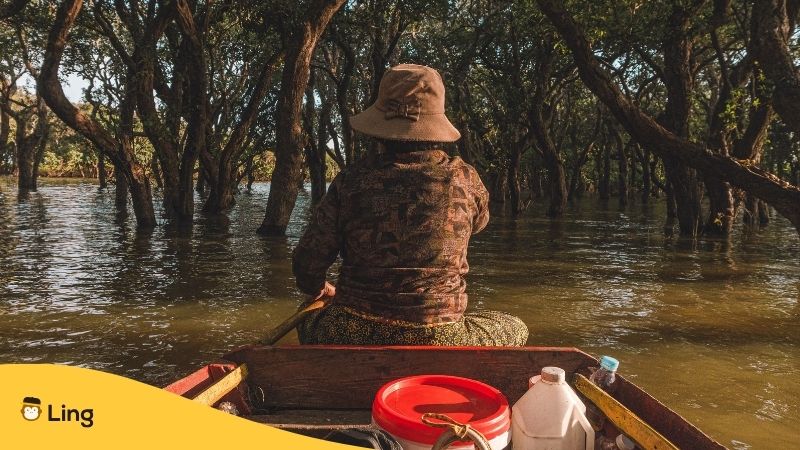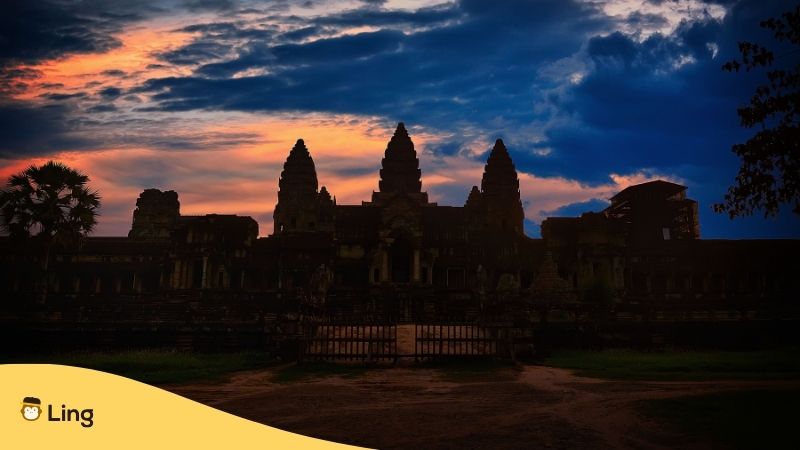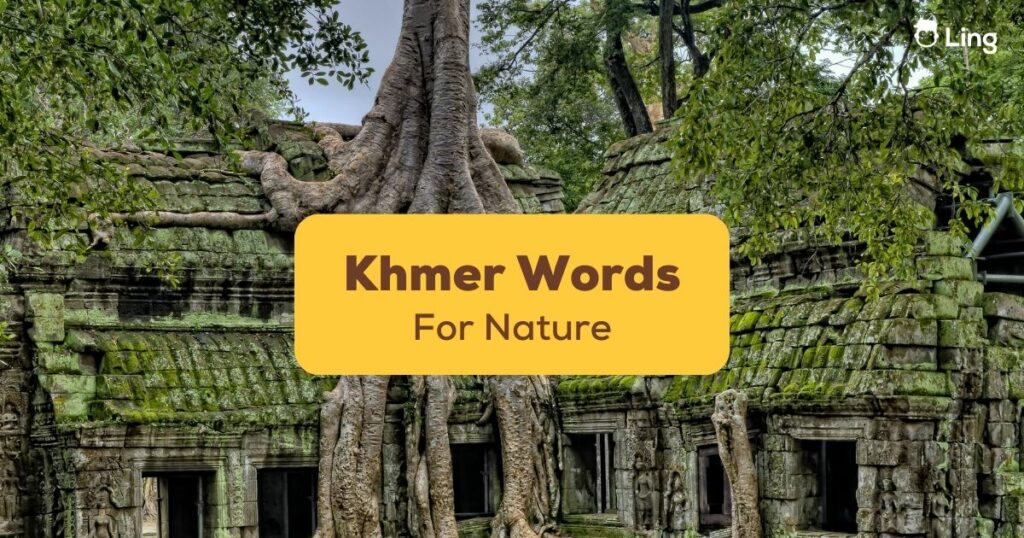As a Southeast Asian nation blessed with stunning natural landscapes and incredible ancient architecture, Cambodia has developed a rich vocabulary of Khmer words for nature & environment.
In this piece, we will delve into the Khmer language and explore the fascinating words that encapsulate the beauty of Cambodia’s spectacular natural environment.
Khmer Words For Nature
In the Khmer language, the words for nature reflect a deep connection to Cambodia’s lush landscapes. “Pnleu” (ពន្) signifies the lush greenery of forests, while “Tompot Prey” (ទំពត់ព្រៃ) evokes the wild beauty of nature. “Tuk” (ទឹក) encapsulates the importance of water, essential for Cambodia’s agriculture and life.
Now, let’s look at some other words for nature in the Khmer language.
Earth: Phendei (ផែនដី)
Let’s start with the very foundation of nature and the environment – the earth itself. Since 2010 Cambodia has celebrated Earth Hour where citizens across the country turn off their lights for an hour to highlight the need to save power and energy to help the planet.
Moon: Preah Chn (ព្រះច័ន្ទ)
The moon has a special place in Khmer culture and is associated with religious festivals and folklore. In fact, Preah (ព្រះ) means god and the word reflects the reverence and mystique surrounding the sacred moon.
Forest: Prey (ព្រៃ)
Cambodia is home to lush forests that cover a significant portion of the country. The word “ព្រៃ” (Prey) encompasses the beauty and importance of these woodlands. In Khmer culture, forests are not just sources of timber and natural resources; they are sacred spaces, teeming with life, and crucial to maintaining the ecological balance. Cambodia is one of the most forested nations on the planet, but in recent years, massive deforestation has threatened to strip the country of this accolade.

Water: Tuk (ទឹក)
Water is the essence of life, and in Khmer, “Tuk” (ទឹក) is the word used to describe it. Cambodia’s abundant rivers, lakes, and wetlands have played a vital role in the nation’s history and continue to support its agriculture and biodiversity. The Tonlé Sap (ទន្លេសាប) fed by the Mighty Mekong (មេគង្) is Southeast Asia’s largest freshwater lake.
Fire: Pleung (ភ្លើង)
Fire has both destructive and transformative qualities, and “Pleung” (ភ្លើង) represents this duality in Khmer. Fire is essential for cooking, warmth, and some traditional Cambodian rituals. However, it can also be a destructive force when it sweeps through forests and fields, especially during the annual burning season.
Mountain: Phnom (ភ្នំ)
Cambodia may be known for its flat terrain and low-lying plains, but it is not without its hills and mountains. “Phnom” (ភ្នំ) is the word used to describe these elevated landforms. The translation of Cambodia’s capital Phnom Penh (ភ្នំពេញ) literally means Penh’s hill, after the widow who found some Buddha statues in a tree trunk floating on the Tonlé Sap (ទន្លេសាប) and asked the locals to create a hill on which to build a temple out of the tree trunk to house the statues.
Village: Phoumi (ភូមិ)
In Cambodia, the concept of a village is closely tied to nature and the environment. “Phoumi” (ភូមិ) refers to a small community or settlement, often nestled amidst rice fields, orchards, and gardens. Villages are the hubs of traditional agricultural life.
Flower: Phka (ផ្កា)
The Khmer language is rich in words that describe the flora and fauna of Cambodia. “Phka” (ផ្កា) is the term for a flower. Cambodia’s tropical climate supports a dazzling array of blossoms, from vibrant orchids to delicate lotus flowers. The national flower of Cambodia is the “rumduol” (រំដួល) that can be made into a sweet-smelling lip wax – “kramuon rumduol” (ក្រមួនរំដួល).
River: Tonle (ទន្លេ)
Rivers are the lifeblood of Cambodia, providing water for irrigation, and transportation, and supporting a rich aquatic ecosystem. Most of Cambodia’s rivers flow into the Tonlé Sap (ទន្លេសាប) or the Mekong (មេគង្) and many of Cambodia’s ancient temples and settlements are located along the banks of these sacred waterways.
Dawn: Prolum (ព្រលឹម)
Dawn marks the beginning of a new day and the awakening of nature. “Prolum” (ព្រលឹម) represents this beautiful moment when the sun’s first rays pierce the darkness. It symbolizes hope, renewal, and the continuous cycle of life in the natural world.

Sunset: Thngailich (ថ្ងៃលិច)
As the day comes to a close, the Khmer word “Thngailich” (ថ្ងៃលិចជ) describes the magical moment of sunset. Cambodia’s landscapes are particularly stunning at this time, with the sun setting over rice fields, rivers, and mountains. Sunsets are not just visually captivating; they also inspire reflection and gratitude for the beauty of nature.
Harmony: Pheap Sokhdom (ភាពសុខដុម)
And finally, we have harmony “Pheap sokhdom” (ភាពសុខដុម) a word that represents balance, not only in human relationships but also in the relationship between the social environment and nature. Cambodians deeply value the idea of living in harmony with their environment, recognizing that it is essential for their well-being and the sustainability of the planet.
Some More Useful Khmer Words For Nature
| English | Khmer | Pronunciation |
|---|---|---|
| Nature | ធម្មជាតិ | Thommocheate |
| Environment | បរិស្ថាន | Bristhean |
| Trees | ដើម | Daeum |
| Animals | សត្វ | Sat |
| Sky | មេឃ | Mekh |
| Ocean | មហាសមុទ្រ | Mhasamout |
| Sun | ព្រះអាទិត្យ | Preahatit |
| Rain | ភ្លៀង | Phlieng |
| Clouds | ពពក | Popok |
| Wildlife | សត្វព្រៃ | Satvaprei |
| Conservation | ការអភិរក្ស | Kar aphirok |
| Pollution | ការបំពុល | Kar bampoul |
| Ecosystem | ប្រព័ន្ធអេកូឡូស៊ី | Brapnth ekaulausai |
From the earth beneath their feet to the sky above, the Khmer language beautifully encapsulates the essence of nature and the environment in Cambodia. These words remind us of the importance of appreciating, preserving, and living in harmony with the natural world, a lesson that transcends borders and cultures and is crucial for the future of our planet.
Keep Up Your Khmer With Ling
As well as everything you need to continue with your Khmer, Ling offers 60+ different languages to choose from including most other Asian languages. If you are looking for an all-in-one language learning package, Ling is the one-stop shop for you. Try the Ling app today by clicking on Google Play or the App Store.





























































